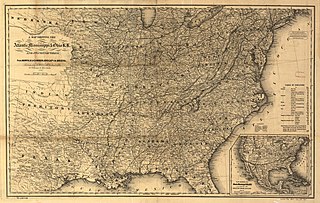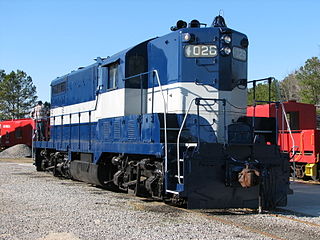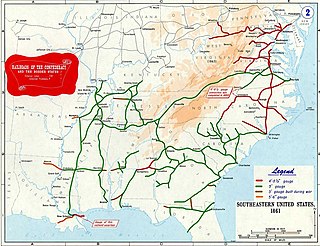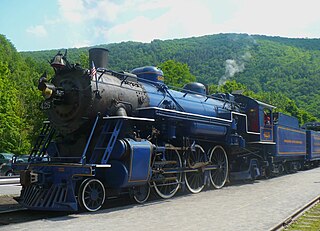
U.S. Route 45 is a major north-south United States highway and a border-to-border route, from Lake Superior to the Gulf of Mexico. A sign at the highway's northern terminus notes the total distance as 1,297 miles (2,087 km).

The Illinois Central Railroad, sometimes called the Main Line of Mid-America, was a railroad in the Central United States, with its primary routes connecting Chicago, Illinois, with New Orleans, Louisiana, and Mobile, Alabama, and thus, the Great Lakes to the Gulf of Mexico. A line also connected Chicago west to Sioux City, Iowa (1870). There was a significant branch to Omaha, Nebraska (1899), west of Fort Dodge, Iowa, and another branch reaching Sioux Falls, South Dakota (1877), starting from Cherokee, Iowa. The IC also serviced Miami, Florida, on trackage owned by other railroads

The Alabama & Gulf Coast Railway is a Class II railroad owned by Genesee & Wyoming. It operates 339 miles (546 km) of track from the Pensacola, Florida export terminals, west of downtown, north to Columbus, Mississippi, with trackage rights along BNSF Railway to Amory, Mississippi. A branch uses trackage rights along Norfolk Southern from Kimbrough, Alabama west and south to Mobile, Alabama, with separate trackage at the end of the line in Mobile.

The Gulf, Mobile and Ohio was a Class I railroad in the central United States whose primary routes extended from Mobile, Alabama, and New Orleans, Louisiana, to St. Louis and Kansas City, Missouri, as well as Chicago, Illinois.

Atlantic, Mississippi and Ohio Railroad (AM&O) was formed in 1870 in Virginia from three east–west railroads which traversed across the southern portion of the state. Organized and led by former Confederate general William Mahone (1826-1895), the 428-mile (689 km) line linked Norfolk with Bristol, Virginia by way of Suffolk, Petersburg, Lynchburg, and Salem. The AM&O was promoted as a trade link to the west, and further expansion was envisioned with the goal of increasing Virginia's Ohio Valley and Mississippi Valley commerce. It was heavily backed by investors from England and Scotland.

The Georgia Railroad and Banking Company also seen as "GARR", was a historic railroad and banking company that operated in the U.S. state of Georgia. In 1967 it reported 833 million revenue-ton-miles of freight and 3 million passenger-miles; at the end of the year it operated 331 miles (533 km) of road and 510 miles (820 km) of track.

The American Civil War was the first in which large armies depended heavily on railroads to bring supplies. For the Confederate States Army, the system was fragile and was designed for short hauls of cotton to the nearest river or ocean port. The South had very little manufacturing or industrial capacity, and so during the war new parts were hard to obtain, and the system deteriorated from overuse, lack of maintenance, and systematic destruction by Union raiders.

The Alabama Southern Railroad is a class III railroad that operates in the southern United States. The ABS is one of several short line railroads owned by Watco. The railroad operates an 85-mile (137 km) line leased from the Kansas City Southern Railway (KCSR). It began operating in 2005.
Bird's Point is an unincorporated community in Mississippi County, Missouri, United States. It lies on an island or former island in the Mississippi River, near the confluence of the Ohio and Mississippi Rivers and is situated directly across from Cairo, Illinois. This is the point where the U.S. Route 60 bridge connects with Cairo.

The Gulf, Mobile and Northern Railroad was a railroad in the Southern United States. The first World War had forced government operation upon the company; and in 1919, when it became once more a free agent, it chose Isaac B. Tigrett to chart its new course. Tigrett, a native of Jackson, Tennessee, was president of the GM&N from 1920 and of its successor, the GM&O, from 1938 to 1952, and oversaw the development of the road from a nearly bankrupt operation into a thriving success. He was the great-uncle of Hard Rock Cafe founder Isaac Tigrett, also a native of Jackson.

The Gulf, Mobile and Ohio Passenger Terminal is a historic train station in Mobile, Alabama, United States. Architect P. Thornton Marye designed the Mission Revival style terminal for the Mobile and Ohio Railroad. It was completed in 1907 at a total cost of $575,000. The Mobile and Ohio merged with the Gulf, Mobile and Northern Railroad in 1940 to form the Gulf, Mobile and Ohio Railroad.
The West Tennessee Railroad is a shortline railroad in the Southern U.S., connecting Corinth, Mississippi, to Fulton, Kentucky, via western Tennessee. The company began operating in 1984 on a portion of the former Mobile and Ohio Railroad (M&O) main line between Jackson and Kenton, Tennessee. It significantly expanded operations in 2001 through the lease, from the Norfolk Southern Railway, of the ex-M&O south to Corinth and a former main line of the Illinois Central Railroad (IC) north to Fulton, as well as a branch from Jackson to Poplar Corner. All of these lines were part of the Illinois Central Gulf Railroad (ICG) prior to its 1980s program of spin-offs, during which Gibson County purchased the Jackson-Kenton line and the Southern Railway acquired the Corinth-Fulton line and Poplar Corner branch.
The following is a brief history of the North American rail system, mainly through major changes to Class I railroads, the largest class by operating revenue.
The following is a brief history of the North American rail system, mainly through major changes to Class I railroads, the largest class by operating revenue.
The Gulf and Mississippi Railroad was the first regional railroad in the United States upon its creation in 1985. With over 713 miles (1,147 km) of track in the states of Mississippi, Tennessee, and Alabama it was among the largest spin-off railroads in the post-Staggers Act era. MidSouth Rail acquired the entire G&M railroad in 1988, operating it as a separate entity, SouthRail. Kansas City Southern purchased MidSouth Rail in 1994 and most of the former G&M lines are still in service under KCS.
The Autauga Northern Railroad is a shortline operating between Maplesville, Alabama and a plant of the International Paper Company near Prattville, Alabama, 43.62 miles (70.20 km). This trackage is leased from Norfolk Southern and was originally operated by the Mobile & Ohio, Gulf, Mobile & Ohio (GM&O), and Illinois Central Gulf railroads as part of their line between Montgomery, Alabama and Tuscaloosa, Alabama. In addition, Autauga Northern uses 10.08 miles (16.22 km) of trackage rights over CSX, also ex-GM&O, to gain access into Montgomery. The lease from Norfolk Southern was approved in February 2011, and operations began in April 2011 as part of Watco.

The Ripley & New Albany Railroad is a 27-mile long (43 km) shortline railroad that runs from New Albany to Falkner, Mississippi, and previously extended from Houston, Mississippi, to Middleton, Tennessee, along former Gulf, Mobile and Ohio Railroad trackage. RNA interchanges with the BNSF Railway in New Albany, Mississippi. It primarily hauls lumber products and Oil-Dri.
The Vicksburg, Shreveport and Pacific Railway was chartered as the Vicksburg, Shreveport, & Texas Railroad Company with an east and west division on April 28, 1853, to be a link, via a transfer boat, between Vicksburg, Mississippi, Shreveport, Louisiana, and points west.














